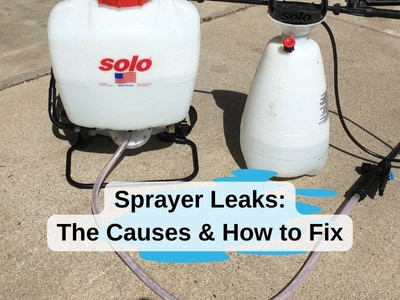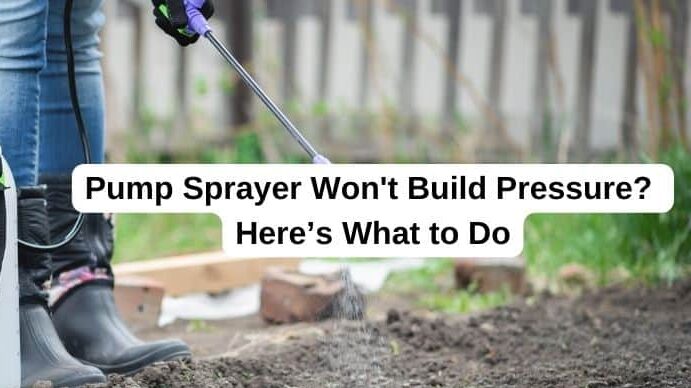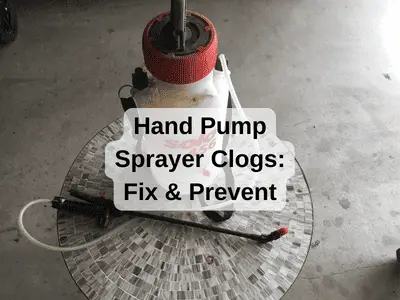If you are new to spraying and maintaining a lawn there are likely going to be some new terms and phrases you hear when you go searching for guidance. A simple thing like the differences between a tank sprayer and a hose-end sprayer might sound self-explanatory but may require clarification. When I got into this industry I faced this very issue myself.
A hose-end sprayer is a simple, user-friendly apparatus that attaches directly to your garden hose while a tank sprayer is a device that consists of a tank to hold the liquid, a pump to create pressure, and a nozzle or wand for application.
While both serve the purpose of dispersing fertilizers and pesticides, they operate differently and have their unique advantages and disadvantages. Let’s dive into what sets these two types of sprayers apart.
Hose-End Sprayers vs Tank Sprayers: What is the Difference?
As the names of both a tank sprayer and a hose-end sprayer would suggest, a tank sprayer is a sprayer with a tank, while a hose-end sprayer is mounted on the end of a garden hose. While hose-end sprayers are all very similar, differing only slightly in their design. Tank sprayers come in a wide scope of sizes and have different features.
Hose-End Sprayers
A hose-end sprayer is a small bottle of concentrated fertilizer or pesticide that attaches directly to your garden hose. It typically consists of a container for the chemical and a siphon mechanism in the head of the sprayer.
Different Types
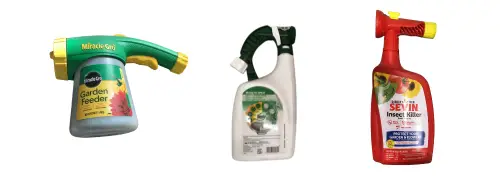
While generally speaking all hose end sprayers are essentially the same. There are two main types. Hose-end sprayers come with a premixed pesticide or fertilizer product, and hose-end sprayers come with an empty bottle for you to add your chemical. There are also several different brands and there may be slight variations between them.
Parts of a Hose-End Sprayer
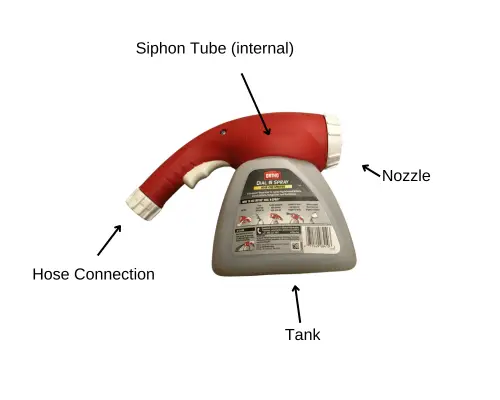
How it Works:
- The water moving through the hose-end sprayer draws the chemical from the container into the mix, dispensing it evenly as you spray.
- The siphon tube inside the sprayer ensures that the chemical is drawn at a consistent ratio.
- The User is responsible for maneuvering the hose to cover the desired areas.
Advantages:
- Ease of Use: Hose-end sprayers are incredibly simple to set up and operate.
- Consistent Mixing: They automatically mix the chemical with water at a set ratio.
- Mobility: Being attached to a hose means you can move around easily, covering different areas of your lawn or garden.
- Low cost: hose end sprayers are very inexpensive compared to other sprayers. Typically they are disposed of after the initial chemical inside is used.
Limitations:
- Range: Your reach is limited to the length of your garden hose.
- Capacity: Typically, hose-end sprayers have a smaller capacity, ranging from 16 to 32 ounces.
Tank Sprayers
A tank sprayer is a self-contained liquid application tool that allows the operator to apply fertilizers or pesticide solutions to different areas. Unlike a hose-end sprayer, the water and chemicals are mixed in the sprayer’s tank. Tank sprayers typically are made up of the tank, pump assembly, hose, and spray wand.
There is a wider range in size and scope of tank sprayers. The term “tank sprayer” can refer to small hand pump sprayers but also to large spray rigs used for commercial lawn and tree care.

How it Works:
- Water is added to the tank along with the chemical product you want to spray.
- The chemical and water must be mixed according to the guidelines on the chemical label to achieve the desired result.
- Depending on the type of tank sprayer you either manually pump the sprayer to build pressure or turn on the electric/engine-driven pump before using the spray wand to apply the mixture.
Advantages:
- Capacity Variations: Tank sprayers come in various sizes, catering to different needs.
- Application Control: They offer more control over the application, especially more advanced units with adjustable pressure controls.
- Versatility: Suitable for both residential and commercial use, with various pump types and features.
Limitations:
- Manual Operation: Requires physical effort to pump and maintain pressure (except for motorized versions).
- Bulkiness: Can be heavier and less maneuverable compared to hose-end sprayers
- Mixing: The user must correctly mix the chemical/fertilizer with water to apply an appropriate and safe amount.
Tank Sprayer or Hose-End Sprayer: Which One Should You Use
So we’ve covered the differences between a hose-end sprayer and a tank sprayer, but which one should you use? The choice depends on your specific goals and application. The size of the area, the specific chemical sprayed, your budget, and other factors will play a role in the decision.
Mixing
A hose-end sprayer has essentially an unlimited supply of water. You can spray as long as there is still chemical in the bottle, plus you never have to worry about mixing. On some models you can adjust the siphon rate, but other than that you don’t need to calculate your mix ratio.
Doing the math to mix your spray solution correctly, as well as calibrating a sprayer can be time-consuming and tedious. With hose-end sprayers, much of this work is eliminated. It is about as simple an option there is for applying a product to your lawn.
By the way, if you are looking for a simple guide to calibrate sprayers, check out these resources:
A tank sprayer will need to be refilled and mixed every time the tank runs empty. This means more handling of chemicals and the potential for spills. If you want to avoid handling chemicals, the pre-packaged hose-end sprayers are the way to go.
Pre-packed hose-end sprayers come with a product already in the bottle. These might be pesticides or fertilizers. Some hose end sprayers do not come with any product in the bottle and you do have to buy chemicals separately and add them to the bottle.
Operation
Hose-end sprayers utilize a venturi to pull the contents in the bottle on the sprayer into the nozzle with the water coming in from your garden hose. The venturi effect will not work properly without adequate flow.
What does this mean for you? Well, if you have a spigot or faucet with low flow it may not work. If you have a garden hose with a small inside diameter it may reduce flow. Likewise, if you try to use an extremely long hose, say 200 feet or more, this can also reduce the flow enough to limit the hose-end sprayer’s ability to “suck” up the product in the bottle and effectively disperse it onto your lawn.
This is not an issue with a hand pump tank sprayer. The contents are already mixed and as long as your pump is in good working order, you can disperse it evenly on your yard.
Hand pump sprayers generally will have a lower flow rate than a hose-end sprayer. This means that they are better suited for spot applications that require a small amount of fluid applied to an area. For example, you can spray cracks in sidewalks, or spray along a foundation without soaking the entire area and wasting product.
Cost
A hose-end sprayer is generally a less expensive option. I examined a variety of different hose-end sprayers and compiled a list of nine that provide a good cross-section of the different styles and variations on the market. The average price was just under $18 each.
The most expensive was $40 and the least expensive was $7. The price difference was due to the quality of the materials and the added features and ergonomics of the more expensive options. Here are the nine hose-end sprayers I compared:
Hose-End Sprayers Cost
(Note this is not necessarily an endorsement of any of these as I have not tried them all. This meant to show the variations between the specific models available.)
| Sprayer Model | Container Size (oz) | Price (US$) | Includes Fertilizer/Pesticide (Y/N) |
| Ortho Dial N Spray Hose-End Sprayer | 32 | 14.97 | No |
| Miracle-Gro Water Soluble All Purpose Plant Food and Garden Feeder | Not available | 16.97 | Yes |
| Scotts Liquid Turf Builder with Plus 2 Weed Control | 32 | 20.19 | Yes |
| Ortho BugClear Insect Killer Liquid 32 oz | 32 | 14.99 | Yes |
| Chapin International G364D Professional Hose-end Sprayer | 32 | 39.99 | No |
| Chapin G390 Hose End Sprayer | 32 | 7.01 | No |
| RL Flo-Master Chameleon Hose-End Sprayer | 36 | 11.27 | No |
| Rocky Mountain Goods Hose Sprayer Attachment | 16 | 25.95 | No |
| Hudson 2100 Hose-End 26 oz Sprayer | 26 | 10.44 | No |
Average Cost: $17.98
Tank Sprayer Cost
Many, many, different types of sprayers could be considered tank sprayers. Most, people probably think of a hand pump sprayer when they think of tank sprayers. That being a 1-3 gallon tank, hand pump assembly, hose and spray wand.
I looked up the cost of several different hand pump tank sprayers of varying sizes and brands:
(Note this is not necessarily an endorsement of any of these as I have not tried them all. This meant to show the variations between the specific models available.)
| Hand Pump Tank Sprayer | Capacity | Cost (US $) |
| Chapin 16200 2-Gallon Made in USA Garden Pump Sprayer | 2 gal | 24.99 |
| Solo 430-2G 2-Gallon Farm and Garden Sprayer | 2 gal | 36.5 |
| PetraTools 2 Gallon Lawn & Garden Pump Sprayer | 2 gal | 34.99 |
| Chapin 1002 48-Oz Made in USA Heavy-Duty Multi-Purpose Sprayer | 48 oz | 20.26 |
| D.B. Smith Contractor 190216 2-Gallon Sprayer | 2 gal | 46.99 |
| Ace 2 Gallon Sprayer Pump | 2 gal | 23.99 |
| Solo 430-3G 3-Gallon Farm and Garden Handheld Sprayer | 3 gal | 41.99 |
| Scotts 190567 Lithium-Ion Battery Powered Pump | 2 gal | 85.97 |
| Chapin International 16144 1 Gallon Multipurpose Sprayer | 1 gal | 13.75 |
(Note this is not necessarily an endorsement of any of these as I have not tried them all. This meant to show the variations between the specific models available.)
Average Cost $36.60
While the overall cost is greater, you do get more flexibility with a tank sprayer. You can use it almost anywhere, even indoors. Plus you can change the spray nozzles to apply a greater volume or different type of spray pattern if desired. This is typically not going to be the case with a hose-end sprayer.
The bottom line is that even though the cost is greater for a tank sprayer, in many cases it is only slightly more, and you get a more versatile product.
Safety
Safety is a priority. One thing about a hose and sprayer to consider is that there is a potential that if the backflow prevention check valve in the hose and sprayer fails chemicals could potentially get into your garden hose and back to your water supply.
This is unlikely but there is still a risk. With a tank sprayer, the hose is not ever connected to the sprayer so there is no risk that any of the chemicals in the sprayer will contaminate your water supply.
A hose-end sprayer with product already in the bottle means that you won’t have to handle or mix chemicals. This is a major benefit if you prefer to avoid mixing or handling chemicals. It is still advisable to use gloves and eye protection when using these sprayers.
Convenience
I consider convenience a huge factor when comparing sprayer types. If you’re going to spend some money on a sprayer of your own, you want to make sure it’s user-friendly and works for you. If not it might end up on a shelf in the back of your garage collecting dust.
When it comes to the amount of time it takes to get up and running a hose-end sprayer is very quick. you simply screw it onto the end of your garden hose, turn on the water, and then you can get started.
Tank sprayers require a bit more setup. You must mix the product with the water, being certain to measure everything according to the label. You have to buy chemicals separately and learn how to properly use them according to the label.
Some hoses and sprayers do not come premixed. You have to add chemicals to the bottle each time, but it is still rather simpler to figure out the amount you need to use. You simply pour the chemical directly into the bottle based on the label instructions for the area you want to spray. The dilution occurs inside the hose-end sprayer’s nozzle as the water moves through it.
All in all hose end sprayers offer more convenience in most cases. However, it can be inconvenient to have to drag the hose around your yard to spray if there are a lot of obstacles. It’s also difficult to have a long run of hose from a far-off water source. This can result in kinked hose wrapped around trees, fence posts, etc. So if you have a yard with many obstacles, a tank sprayer could end up being more convenient.
I like to use both types of sprayers. They meet different needs. When you have an area close to your house or you can easily run a hose from a spigot and reach the entire area, a hose-end sprayer works great. It’s fast and I don’t need to think about measuring liquid, pouring, and risking a spill.
But I also like to use a tank sprayer to spray remote areas. I live on an acreage with a large lawn. So I would need hundreds of feet of garden hose to cover my whole lawn with a hose-end sprayer. A hand pump tank sprayer allows me to not be tied up by a hose and it works in several different applications.
Comparing the Operation of Hose-end Vs Tank Sprayers
Seeing these two types of sprayers in action is the best way to clearly show the differences. This video offers a great example of how a tank sprayer and hose-end sprayer are used as well as the specific application methods required:
You can see that both types of sprayer rely on the operator’s motion and technique to apply the liquid evenly. To achieve even coverage the operator must maintain a consistent motion with the spray gun for each type of sprayer. So when you are considering accuracy, neither sprayer type necessarily has an advantage.
The volume applied is also noticeable in the video. The hose-end sprayer delivers a larger volume of liquid through the nozzle. This makes it easier to cover a large area, but you are still limited to where you can go by the length of your hose.
Tank sprayers, like the one shown in this video, will deliver a low volume but they can go anywhere you can walk. There are tank sprayers that are larger and produce more volume. They use larger nozzles and often have electronic pumps. These sprayers cost more, but they make your job much easier and more efficient.
If you have a large property then a larger tank sprayer may be well worth the investment. If you think a larger sprayer may be right for you but want more information, then be sure to read this guide to select the right sprayer type.
The Bottomline
Hose-end sprayers and tank sprayers are both liquid application tools. The fundamental difference is in the way they hold the liquid. They are both useful tools and understanding the differences between them can help you to decide which one will work best for your scenario. Choosing between them depends on your specific needs and the scope of your application.
For a more in-depth look into different types of tank sprayers and their specific applications in lawn and garden care, be sure to check out our other detailed resources. Remember, the right sprayer can make all the difference in your lawn care routine!

